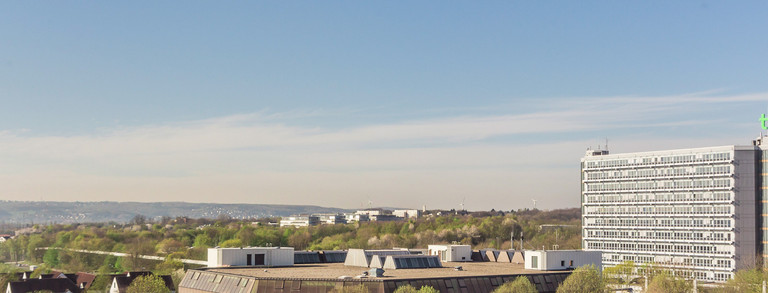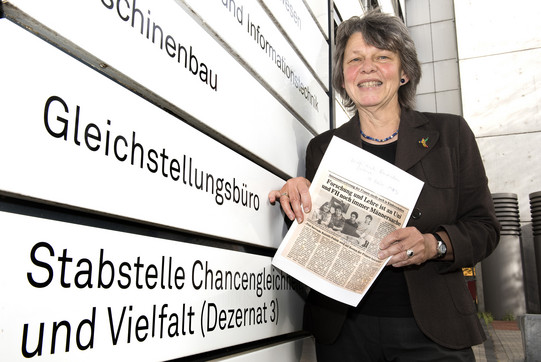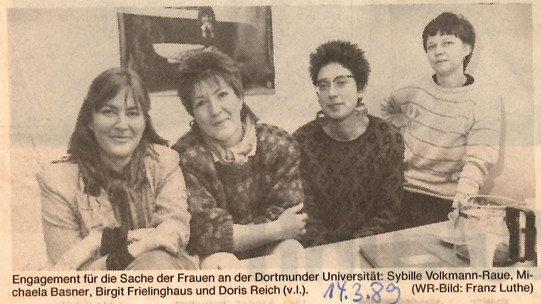In conversation with the first women's representative
In 1988, Doris Reich took up her position as Women's Representative at the former University of Dortmund. To mark the 30th anniversary of equal opportunities work at TU Dortmund University, we met Doris Reich for an interview and talked to her about her commitment to a gender-equal university and the beginnings of the Equal Opportunities Office.
Ms. Reich, you were the first Women's Representative at the former University of Dortmund from 1988-1989.
"We were a team of four women, which is important for me to emphasize. We had an egalitarian principle and said that we wanted to represent all four groups: the female students, the female non-scientists, the female middle managers and the female university lecturers. It was also important to represent the status groups through different people because the problems were different.
In June 1988, we officially became a team of women's representatives. This first team included Michaela Basner as a non-scientist, she was a technical draughtswoman in civil engineering. Birgit Frielinghaus was a student who, like me, came from the Department of Spatial Planning. The female university lecturers were represented by psychology professor Sybille Volkmann-Rauhe. And I was there as a representative of the academic staff. We were of the opinion that there should be women's representatives at the universities in addition to the women's representatives in the municipalities."
How did equal opportunities work at the University of Dortmund begin?
"In the 1980s, the office of women's representative was not yet enshrined in university legislation; that only came later. Here at the University of Dortmund, the efforts to establish such an office clearly came from below and were later taken up by the university management. The basic regulations of the University of Dortmund were only changed after my term of office so that there had to be a women's representative and a deputy. It then stated: 'On the recommendation of the female members of the university, the Women's Representative and her deputy are elected by the Senate for a term of office of two years and appointed by the Rector'.
So at the University of Dortmund there was first the team of women's representatives and then the institutional anchoring. We brought the issue to the committees and the office was then officially established on our initiative. In summary, there was a large social movement outside the university, then there were people within the university who promoted the issue of equality. Afterwards, there was no way around giving in to this and anchoring it. There was no direct resistance or obstacles put in the way during the whole process, but it was very tough. There were also headwinds from some people; not everyone loved the issue. Above all, there were people in the Senate who didn't want to deal with the women's issue. But I think there was enough power from below not to let up."
Did you come to university with a women's movement?
"No, no. It wasn't an issue for me during my studies, it only started when I started working. So I think it also had something to do with extramural efforts. For example, I was aware of the developments against Section 218. It was the time when women took to the streets or made publications. There was a very active women's scene in the Ruhr area, there was an education section for women at the adult education center, discussion groups were offered, etc. There was also the first women's center in Dortmund. It was a time when a lot was happening. At the university too.
I started studying in 1971. I'm the eldest of three daughters and the first to go to university. My parents didn't put any obstacles in my way, although this was a time when women were not allowed to work or open their own bank account without their husband's permission. During my studies, it was noticeable that there were very few women. In the beginning, we women were more concerned with not standing out among the many men. We only had one female professor in spatial planning at the time, who worked in the field of sociology. That was Prof. Spiegel. She was the first female professor at the University of Dortmund and an important role model for me. Prof. Spiegel worked on the topic of 'family and housing'.
I completed my studies in 1977. The degree I was awarded back then was still called 'Diplom-Ingenieur'. When the opportunity arose in the 1980s, I had it changed to 'Dipl.-Ingenieurin'. After graduating, I worked at the University of Dortmund for almost ten years, with brief interruptions. After the women's studies conferences, we regularly offered study projects for female students and lecture series, which we organized on a voluntary basis with the spatial planning student council. Then there was a new professor in sociology who took good note of this. When a position became available, I applied for it with a focus on 'Women's Studies in Spatial Planning'. For four years, I had the opportunity to develop this area in the field of 'Sociological Foundations of Spatial Planning'. This focus led to a professorship with Prof. Becker for quite a while.
Because I was only given temporary contracts at the university for ten years, I moved from the university to our planners' association in 1990. As FOPA, a feminist organizationof female plannersand architects, we had set up an office in Dortmund. The work of the association had already begun a few years earlier. In addition to my university work, I was always on the association's board. One of FOPA 's aims was to create paid jobs for women. At that time, there was also the instrument of the job creation scheme, ABM for short. We interpreted this as ' makingwork pay'. We also wanted to open up unusual topics for women that were not yet socially promoted.
In later years, I set up my own business with a colleague. We had an office in Dortmund. I also had the opportunity to take on a guest professorship in Kassel. Women's issues in spatial planning were also the central topic there."
What was your personal motivation to take on the role of Women's Representative at the University of Dortmund?
"I came to Dortmund as a high school graduate to study spatial planning here. I was 19 years old at the time and came from Lower Saxony because I was interested in this new course of study in spatial planning. At that time, there were very few women in my year who studied spatial planning at all. There were already more women in Emil-Figge 50. Of course, there was also the NRW Women Scientists' Working Group at the University of Dortmund and the efforts to establish women's studies. These women also organized the large women's forum in the region. We had heard about this and then made contact. And then we asked ourselves what the situation was with women in planning: Both on the side of those affected - what is the impact there? - as well as in the profession - what is it actually like for female architects and planners in this field? Who were the first and how did it develop? In the years that followed, I always followed professionally how the proportion of women in planning developed. Later, I also conducted two studies on the subject. On the one hand, together with a colleague, I carried out a retention study on those who studied spatial planning in Dortmund. We asked ourselves where they had ended up and paid particular attention to women. Later, I had the opportunity to conduct another study for the state ministry on career opportunities and labor market opportunities for women in architecture and planning."
Who did you work with at the university? Who supported you? And where did things perhaps "get stuck"?
"We weren't alone. There was this network of female academics working in parallel. The working group for female academics in NRW was set up by Prof. Sigrid Metz-Göckel at the University Didactics Center. She was a real supporter. The University Didactics Center was a great help to us overall. There was more equipment and power, there was a photocopier, you could send letters, you could use the telephone. There was still no office for the women's representatives.
The rector at the time, Prof. Velsinger, who was also a spatial planner, was also a supporter at that time. I can remember that we also approached the rector's office and the issue of equality was met with an open ear. But we also had to go through the formal process and it took two years for the amendment to the basic regulations to be approved by the Senate.
But of course there were different factions within the university. There were those who thought it was really bad and those who supported it. And then there were those who didn't care about the issue."
Today, the Equal Opportunities Office at TU Dortmund University is adequately equipped in terms of space, equipment and staff. What was it like in your time?
"The work wasn't easy overall; as I said, we didn't have an office and we didn't have any money. We did it all on a voluntary basis. It was only our commitment that kept the whole thing going."
Today, the decentralized Equal Opportunities Officers also take the issue of gender equality to the faculties. Was there any cooperation with the individual faculties in your time?
"The university was no longer that small at that time. So we said that it would be good to have contact persons in the individual departments, as they weren't called 'faculties' back then. In terms of a network, everything should be a bit easier that way, for example getting the invitations, flyers and notices out everywhere."
Nowadays, the Equal Opportunities Officer has a variety of tasks. What was it like in your time?
"At that time, there was no job description or anything like that for the office of Women's Representative. We started by taking on all the issues that came up. One topic, for example, was the situation of female students with children. The student representative was very involved in this. We also networked with other universities. For example, we held a large conference at the University of Dortmund in April 1989. The University Didactics Center and we women's representatives invited people to the guest house to exchange experiences. 90 university women's representatives from all federal states met at our university for a first exchange (editor's note: 1st nationwide meeting of university women's representatives). This was the first BuKof, the Federal Conference of Women's and Equal Opportunities Officers at Universities. We organized it with the others to see what the situation was like in the other federal states.
An essential and important point that only came with institutionalization was that the women's representative could be present at recruitment interviews. We weren't allowed to do that yet. In the case of female university lecturers, they made sure that they got women on the appointment committees so that at least there were women on this committee. But that wasn't always so easy."
And what issues did you deal with in your work as Women's Representative for Academic Staff?
"At the time, it was important to me to first of all raise awareness of the fact that women were still in a drastic minority at the university, even in the mid-level faculty. Female professors tended to fight for special research areas and for professorships to be advertised specifically for women. During this time, it was important to first take a purely quantitative look at the proportion of female students, the proportion of female academic staff and the proportion of female professors. At that time, the proportion of women at the level of mid-level academic staff was very, very different from subject area to subject area. It was not so high in spatial planning at the time. In mechanical and chemical engineering, the proportion was even lower than in spatial planning.
In order to reach all women, we held so-called 'women's assemblies'. These usually took place here on campus. We held these plenary meetings for all four groups, mostly in Emil-Figge-Str. 50.
I thought it was very important back then and I still think it's very important to get men on board too. Men should be made aware of careers such as kindergarten, elementary school or nursing. I live with three men, I have two sons. At the time, I had a job at the university and became pregnant. My husband had just got a job in a computer center and I said: 'If I work less now, it's really bad. The university will only save money. We were so committed to our jobs and wanted to see if we could make it work. And then we decided that my husband would temporarily reduce his job so that he could also look after his son. This was at a time when there was no parental leave, but his boss agreed. My husband then shared his job with a young computer scientist, actually it was more than one job because they shared the week. One worked from Monday to Wednesday and the other from Wednesday to Friday. They were there together one day and otherwise coordinated on the phone. And of course we also shared the other tasks. So if the parent-teacher conference was on Thursday, then he went there and if a visit to the pediatrician fell during his time, then of course he went with the child to the vaccination. This model was very, very unusual at the time. It wasn't easy and it was exhausting, but it was important to us."
You gave up the position of Women's Representative after a year because you then left the university. Looking back thirty years later, would you say that you would take on this pioneering role again?
"Yes, I would. I think so."







